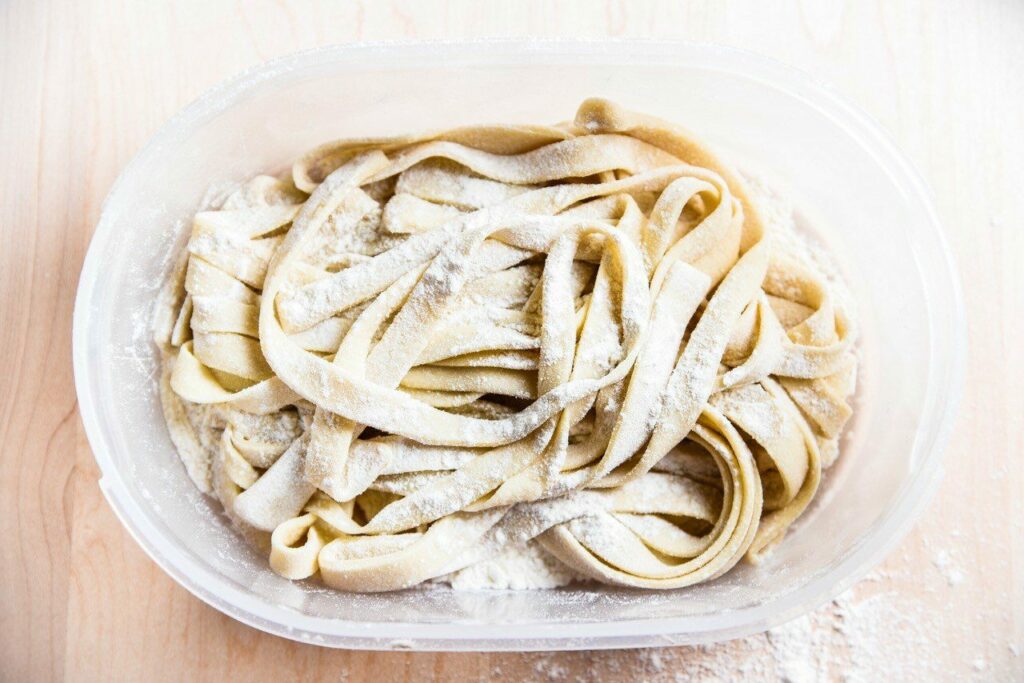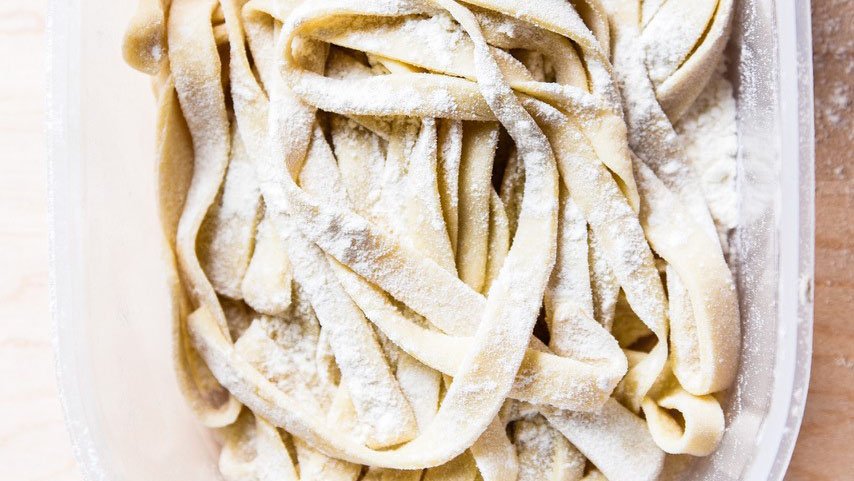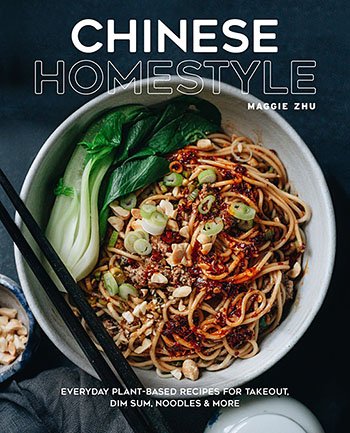
This recipe is an easy way to enjoy freshly made noodles at home. You can make a few batches and freeze them for later. Their chewy texture and nice aroma make them superior to dried noodles. My favorite way to use them is as wide noodles in Biang Biang Mian. You can also use this dough to make super-wide noodles. Cut the noodles 1 inch (2.5 cm) wide, then use your hands to gently stretch out each noodle in all directions so that they will be slightly thinner and have a better texture once cooked.
NOTE: You can also use these noodles in Maggie Zhu’s Sesame Noodles recipe.

Handmade Noodles
Equipment
- Stand mixer optional
Ingredients
- 3 1/2 cups (500 grams) bread flour, plus more for dusting
- 1 cup (240 ml) room temperature water
- Vegetable Oil (optional)
Instructions
To knead the dough by hand:
- Place the flour in a large bowl. Slowly add the room temperature water and mix with a silicone spatula until the flour is fully absorbed. Knead by hand until a dough forms and the bowl is clean of flour. Dust a work surface with flour and transfer the dough onto it. Knead until the surface of the dough becomes smooth, about 10 minutes. The dough should feel very tough and should be able to be easily lifted from the bowl without sticking to the bottom.
To knead with a mixer:
- Place the flour in the bowl of a stand mixer fitted with the dough hook. Turn the mixer on low speed and slowly add the water. Let the mixer run at low speed until the dough becomes consistent and smooth, about 10 minutes total. Transfer the dough to a clean work surface. Knead a few times to shape the dough into a ball.
- Dust a large bowl with flour. Transfer the dough to the bowl. Cover the bowl tightly with plastic wrap. Let the dough rest for 30 minutes to 2 hours at room temperature, or up to overnight in the refrigerator.
- Dust the work surface with flour and transfer the dough onto it. Knead it a few more times, then divide it into 2 equal-size pieces. Knead each piece into a ball. Work on one dough ball, keeping the other ball covered in the bowl to prevent drying out.
- Dust the work surface again. Press the dough ball into a disc. Roll it with a rolling pin into a large, thin rectangle. If you’re going to make wide noodles, try to roll the dough as thin as possible; if you’re going to make thin noodles, the dough sheet can be a bit thicker (about 1/16 inch, or 1.5 mm). If the dough is hard to roll out, cover it with plastic wrap and let rest for another 30 minutes.
- Dust the dough sheet with plenty of flour. Roll it up from the long side like rolling a cinnamon bun, then fold it over twice to form a multilayered long sheet.
- Slice along the short side with a sharp knife to make noodles. Cut the noodle width according to your preference, from 1/16 inch (1.5 mm) to 1⁄2 inch (1 cm).
- Unfold the noodles and shake off any extra flour. Align the noodles on the work surface or hang them on a rack to dry for 30 minutes.
To cook the noodles:
- To cook the noodles, bring a large pot of water to a boil over medium-high heat. Prepare 4 cups (960 ml) of cold water. Add a serving size of noodles, about 1⁄4 pound (113 g), to the boiling water and immediately stir with chopsticks (or tongs) so that they don’t stick to the bottom of the pot. Cook until the noodles are cooked through, about 3 minutes. If the water starts boiling, add some of the prepared cold water to stop the boiling. Use a pair of tongs to transfer the noodles toa strainer. Run them under cold water to stop cooking. Repeat until all the noodles are cooked.
- Serve the noodles in a bowl of broth or top them with sauce.
- The cooked noodles will stick together when they get cold. If you’re not going to serve them immediately, pour a few drops of vegetable oil on them and gently toss by hand. If the noodles are already sticking together, rinse them with warm water and gently toss by hand.
- To store uncooked noodles, dust the bottom of an airtight container with flour, generously sprinkle flour on the noodles, fold the noodles into the container, and cover. Store in the freezer for up to 1 month. To cook frozen noodles, cook them like you would fresh noodles. You don’t need to thaw them before cooking.
Notes
 Excerpted from Chinese Homestyle: Everyday Plant-Based Recipes For Takeout, Dim Sum, Noodles & More by Maggie Zhu. Copyright © 2022 by Quarto Publishing Group USA Inc. Text and photography Copyright © 2022 Maggie Zhu.
Excerpted from Chinese Homestyle: Everyday Plant-Based Recipes For Takeout, Dim Sum, Noodles & More by Maggie Zhu. Copyright © 2022 by Quarto Publishing Group USA Inc. Text and photography Copyright © 2022 Maggie Zhu.

